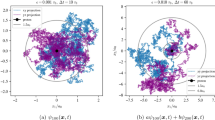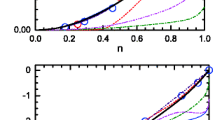Abstract
We propose a Monte Carlo method to obtain the thermodynamic functions of Ising systems. We perform a random sampling of spin configurations to determine the degeneracy of the energies of the system, from which an approximant to the partition function is determined. The main advantage of the method over conventional Metropolis lies in the fact that only a single Monte Carlo run is needed to obtain results valid for all temperatures, magnetic fields, and coupling parameters (FM or AFM). As an illustration of the method, we present results for the Ising model in a magnetic field on a 8x8 lattice. The method can be adapted to tackle the random field Ising model (RFIM), the dilute Ising model, and the Ising spin glass, in any spatial dimension.
Similar content being viewed by others
References
N. Metropolis, W.W. Rosenbluth, M.N. Rosenbluth, A.H. Teller, and E. Teller, J. Comm. Phys.21, 1087 (1953).
See, e.g., K. Binder (ed.),The Monte Carlo Method in Condensed Matter Physics (Springer, Berlin, Heidelberg, 1992), and references therein.
R.H. Swendsen and J.-S. Wang, Phys. Rev. Lett.58, 86 (1987); A.M. Ferrenberg and R.H. Swendsen, Phys. Rev. Lett.61, 2635 (1988);63, 1195 (1989).
D.P. Landau, Phys. Rev. B13, 2997 (1976).
Author information
Authors and Affiliations
Rights and permissions
About this article
Cite this article
Lieu, C., Florencio, J. A novel Monte Carlo simulation method for Ising systems. J Low Temp Phys 89, 565–568 (1992). https://doi.org/10.1007/BF00694088
Issue Date:
DOI: https://doi.org/10.1007/BF00694088




